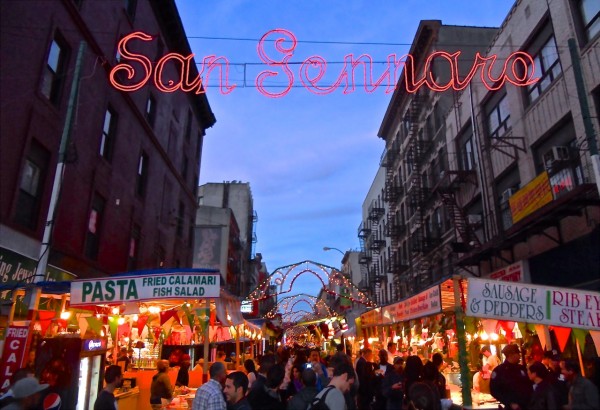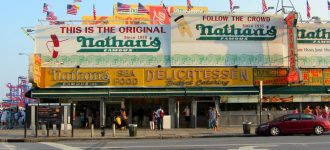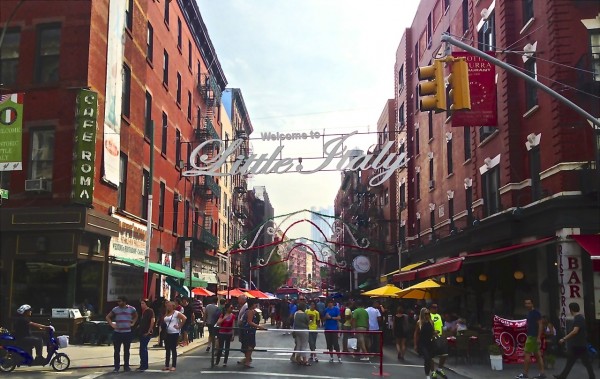
New York City welcomed millions of Italian immigrants in the late 19th and 20th Centuries, becoming home to the nation’s largest Italian population. The new Italian Americans created tight-knit communities in which they established churches, communal organizations, continued cherished traditions, and produced plenty of great food. While most of the Italian immigrant families have left the old neighborhoods, there are still remnants of that original Italian immigrant culture to be found. Here’s a guide to finding that old-world culture in NYC’s historic Italian neighborhoods.
Little Italy
NYC’s best know Italian neighborhood that once covered about 50 blocks of Lower Manhattan. Today it is engulfed by ever-expanding Chinatown and trendy, no-longer-so-Italian Nolita (North of Little Italy). The neighborhood is now just five blocks of Mulberry Street between Canal & Spring and a bit of the intersecting cross streets. According to a recent census, only about 5 percent of residents in the neighborhood are of Italian descent. But, for those looking to experience “authentic” Little Italy, there are still a few businesses run by founding families where you can get a taste of the old neighborhood.
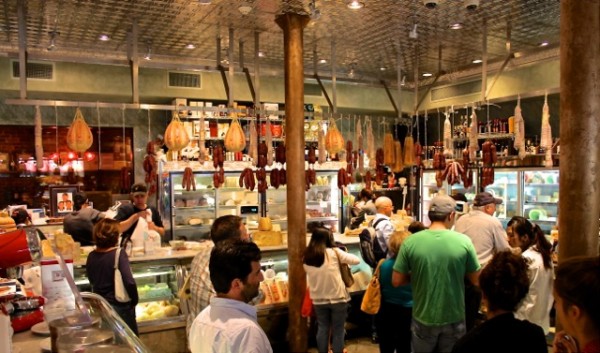
Amongst the tourist trap restaurants and stores hawking cheap souvenirs and “Sopranos” kitsch there are some old-school, family-run Italian ristorantes. They include Angelo’s of Mulberry, La Mela, Benito One, and Floria’s. For details, see our listing of Best Restaurants in Little Italy. Historic Lombardi’s is the nation’s first pizzeria and the font from which NYC’s pizza passion sprang. They still make thin-crust pizza in their original 1905 coal oven.
A number of the neighborhood’s wonderful old food shops have survived and are well worth a visit. They include Alleva Dairy (fresh homemade mozzarella & ricotta), Di Palo’s Fine Foods (Italian charcuterie & cheese, along with a new wine store), Parisi Bakery (fresh breads and deli sandwiches) and Piemonte Ravioli, who make fresh pasta and sauces on the premises and supply most of the nearby restaurants.
Little Italy has some genuine Italian cafes and bakeries serving espresso, cappuccino, and pastries. Relaxing in historic Café Roma is a great “old neighborhood” experience. La Bella Ferrara Bakery is the real thing, where the cannoli, biscotti, traditional cookies and pastries are baked fresh in the basement, and Café Palermo has been called “the Cannoli King of Little Italy.” Famed Ferrara Bakery is an NYC institution, serving Italian sweet treats since 1892.
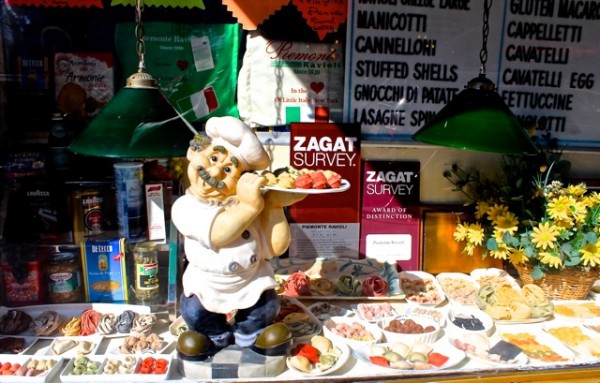
To learn more about old neighborhood, visit the tiny Italian American Museum, housed in the former Stabile Bank. The intimate space (which still includes the vintage teller’s cages and bank vault) displays artifacts from neighborhood families, providing a glimpse at daily immigrant life and important local occasions.
Speaking of museums, a few blocks east is the Lower East Side Tenement Museum, which conducts fascinating immersive tours. One tour visits a recreation of the tenement home of the Baldizzi family. Their Museum Store also stocks excellent books on the Italian immigrant experience in NYC.
Greenwich Village
At the end of the 19th century Italian immigrants began to move into “the Village” to work in the district’s factories. They made their homes south of Washington Square along Bleecker, Carmine, Thompson, and Sullivan Streets, as well as the area that is now west SoHo. They built churches, clubs, food shops, and restaurants to serve their growing community.
Like it’s sister neighborhood, most Italian families have left the Village for the boroughs (either by chose or they’ve been priced out of the costly area). But remnants of the old neighborhood remain at St. Anthony of Padua (the nation’s oldest Italian parish), Our Lady of Pompeii (founded to serve Italian immigrants, where mass is still said in Italian) and Perazzo Funeral Home.
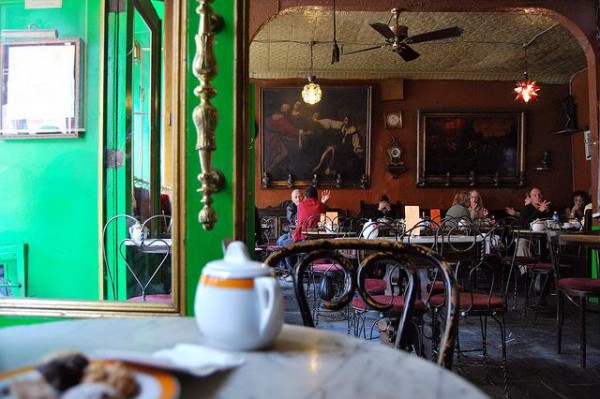
There’s plenty of great Italian food in the Village. Though most Italian restaurants are too new to be considered “old neighborhood joints,” Villa Mosconi and Arturo’s are favorites of the few remaining Italians.
but there are still enduring classics like Faicco’s Pork Store, Raffetto’s, John’s of Bleecker Street (coal-oven pizza), Pasticceria Rocco, Café Dante, and famed Café Reggio (with its 1902 espresso machine – NYC’s first).
For some non-edible Italian culture, the Scuola Italiana del Greenwich Village provides instruction in Italian language and presents a roster of events focused on Italian culture and history.
Arthur Avenue
Many claim Arthur Avenue in the Belmont area of the Bronx is NYC’s “real Little Italy.” The commercial center of this Italian neighborhood is Arthur Avenue, which is lined with restaurants and shops offering excellent Italian dining, foods, house wares and gifts.
Italian Harlem
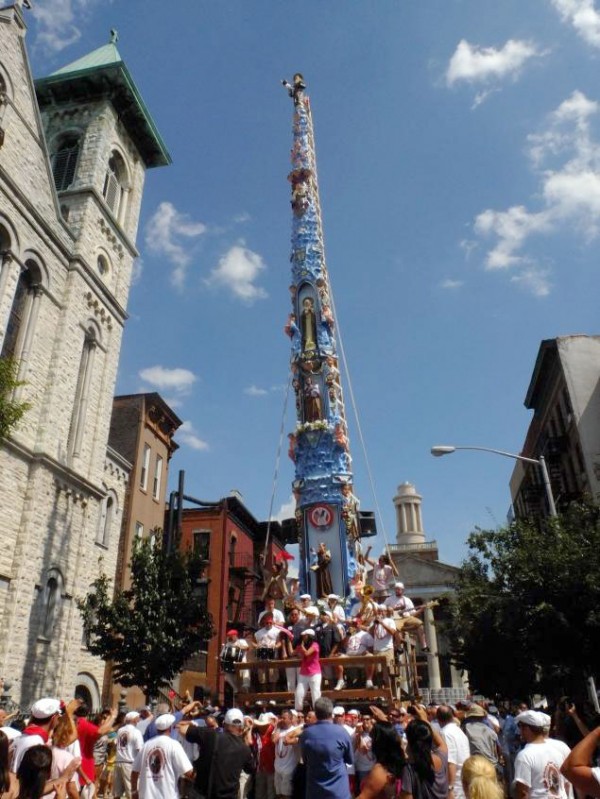
A section of East Harlem that was home to an enormous community of immigrants from Southern Italy in the late 19th & 20th centuries. (In fact, it was the first NYC neighborhood to be labeled “Little Italy.”) At its peak, there were over 100,000 Italians crowded into the tenements and streets that were organized by village of origin. Italians began leaving East Harlem in the 1950s and the area became “Spanish Harlem” as newcomers from Latin America moved into the neighborhood.
Little remains of Italian Harlem. The restaurants Rao’s and Patsy’s Pizzeria are still renowned and popular, and there’s Claudio’s Barbershop (recently saved from eviction by popular demand). Lastly, there’s the community’s spiritual home, Our Lady of Mount Carmel, which now performs services in English and Spanish.
However, one weekend each summer Italian Harlem comes back to life when residents of the old neighborhood return for the Giglio di Sant Antonio. The culmination of the three-day festival is the Dancing of the Giglio, an 80 ft. tower that is carried through the streets in honor of the saint.
